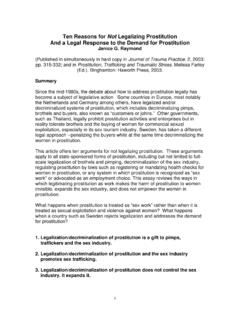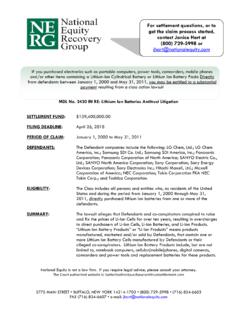Transcription of James O. PrOchaska, PhD, anD Janice m. …
1 Jones & Bartlett Learning, LLC. NOT FOR SALE OR DISTRIBUTION. Chapter Behavior Change 2 James O. prochaska , PhD, and Janice M. prochaska , PhD. Executive Summary Behavior change an essential component of a well-care system Health risk behaviors like smoking, inactivity, unhealthy diets, nonadherence to pre- scribed therapies, and ineffectively managed stress significantly contribute to a popula- tion's morbidity, disability, mortality, reduced productivity, and escalating healthcare costs. To have a significant and sustainable impact on these behaviors, a model of behavior change is needed to address the needs of entire populations, not just the minority who are motivated to take immediate action. The Transtheoretical Model of Behavior Change (TTM) is founded on stages of change, which categorize segments of populations based on where they are in the process of change.
2 Principles and processes are applied to initiate movement through the stages of change. Interventions tailored to specific needs allow programs to be interactive and broadly applicable for treatment of entire populations. Computer Tailored Interventions (CTIs) delivered through various modalities, such as clinical guidance, telephonic counseling, and the Internet produce high impact on both single and multiple behaviors for disease prevention and management. These interven- tions involve new paradigms that complement existing ones, such as proactive stage- matched interventions for multiple behaviors delivered to homes via computers with evidence based on population trials using impact metrics. These integrated paradigms have the potential to provide the foundation for a well-care system, which will comple- ment the existing sick-care system. 23. 23 16/06/10 6:23 PM.
3 Jones & Bartlett Learning, LLC. NOT FOR SALE OR DISTRIBUTION. 24 Chapter 2 Behavior Change Learning Objectives 1. Learn the major constructs of the Transtheoretical Model of Behavior Change (TTM). 2. Select and apply TTM principles at each stage of change when working with patients and populations. 3. Understand the critical assumptions of the TTM. 4. Realize the importance of multiple behavior changes. 5. Describe the provider's role in understanding and managing the behaviors of patient populations. Key Words multiple behavior changes stages of change processes of change Transtheoretical Model of Behavior Change Introduction Healthcare providers and patients have a shared responsibility for population health. As the ultimate authority on their personal health, patients have responsibility for sharing health-related information with their providers. Healthcare providers are responsible for listening to patients' concerns and providing advice accordingly.
4 This shared responsibility is essential for all patient populations and is especially important for those dealing with chronic conditions. Behaviors affect morbidity, and extremely unhealthy behaviors may lead to mortality. Understanding what causes patients to exhibit certain behaviors and what motivates them to change provides information that can be broadly applicable to populations with similar characteristics. In this chapter, we focus on the provider's role in understanding and managing the behaviors of patient populations. Behavior change is important in several domains of chronic care management: (1) in personal health care, when providers work with a patient to change the behaviors that are contributing to or exacerbating the patient's disease; (2) in quality and safety, as it relates to advising patients on the risks of smoking, for example; and (3) in public health activities, in advising populations to receive the H1N1 vaccination for protection from the pandemic.
5 Behavior affects three of the four pillars of population health, demonstrating that it is a key driver in population health management. (See Box 2-1) It is the healthcare provider's role to advise patients on the risks of their behaviors and the benefits of changing unhealthy ones. Providers can follow the Transtheoretical Model of Behavior Change (TTM) in advising patients, but it is the patient's responsibility for accepting the provider's advice and taking action. While this model has traditionally been applied to individuals, it can also be used to describe the health of populations because communities can influence the behavior of its members. 24 16/06/10 6:23 PM. Jones & Bartlett Learning, LLC. NOT FOR SALE OR DISTRIBUTION. Core Constructs 25. Box 2-1 Four Pillars of Population Health Population Health Chronic Care Management Health Policy Quality and Safety Public Health The Transtheoretical Model of Behavior Change The Transtheoretical Model of Behavior Change (TTM) uses stages to integrate processes and principles of change across major theories of intervention hence, the name Trans- theoretical.
6 This model emerged from a comparative analysis of leading theories grounded in psychotherapy and behavior change. Because more than 300 psychotherapy theories were found, the authors determined that there was a need for systematic Ten processes of change emerged, including consciousness raising from the Freudian tradi- tion, contingency management from the Skinnerian tradition, and helping relationships from the Rogerian tradition. In an empirical analysis of self-changers compared to smokers in professional treat- ments, researchers assessed how frequently each group used each of the ten Research participants indicated that they used different processes at different times in their struggles with smoking. These naive subjects were teaching us about a phenomenon that was not included in any of the multitude of therapy theories. They were revealing that behavior change unfolds through a series of This early discovery is the reason that TTM is often applied to smoking-cessation interventions.
7 From the initial studies of smoking, the stage model rapidly expanded in scope to include investigations and applications to a broad range of health and mental health behaviors. Examples include alcohol and substance abuse, stress, bullying, delinquency, depression, eating disorders and obesity, high-fat diets, HIV/AIDS prevention, mam- mography screening, medication compliance, unplanned pregnancy prevention, preg- nancy and smoking, radon testing, sedentary lifestyles, and sun exposure. Over time, behavior studies have expanded, validated, applied, and challenged the core constructs of the Transtheoretical Model. Core Constructs The TTM has concentrated on six stages of change, 10 processes of change, decisional balance (the pros and cons of changing), self-efficacy, and temptation. Stages of change lie at the heart of the TTM. Studies of change have found that people move through a series of stages when modifying behavior.
8 While the time a person can stay in each stage 25 16/06/10 6:23 PM. Jones & Bartlett Learning, LLC. NOT FOR SALE OR DISTRIBUTION. 26 Chapter 2 Behavior Change is variable, the tasks required to move to the next stage are not. Certain principles and processes of change work best at each stage to reduce resistance, facilitate progress, and prevent relapse. These include decisional balance, self-efficacy, and processes of change. Only a minority (usually less than 20%) of a population at risk is prepared to take action at any given time. Thus, action-oriented advice disserves individuals in the early stages. Advice based on the TTM results in increased participation in the change process because it appeals to the whole population rather than the minority ready to take action. Stages of Change The stage construct represents a temporal dimension. Change implies phenomena occur- ring over time.
9 Surprisingly, none of the leading theories of therapy contained a core construct representing time. Traditionally, behavior change was often construed as an event, such as quitting smoking, drinking, or overeating, but the TTM recognizes change as a process that unfolds over time, involving progress through a series of stages. Precontemplation People in the precontemplation stage do not intend to take action in the foreseeable future, usually measured as the next six months. Being uninformed or underinformed about the consequences of one's behavior may cause a person to be in the precontemplation stage. Multiple unsuccessful attempts at change can lead to demoraliza- tion about the ability to change. Both the uninformed and underinformed tend to avoid reading, talking, or thinking about their high-risk behaviors. They are often characterized in other theories as resistant, unmotivated, or unready for health promotion programs.
10 The fact is, traditional population health promotion programs were not ready for such individuals and were not motivated to meet their needs. Contemplation Contemplation is the stage in which people intend to change in the next six months. They are more aware of the pros of changing, but are also acutely aware of the cons. In a meta-analysis across 48 health risk behaviors, the pros and cons of changing were equal. This weighting between the costs and benefits of changing can produce profound ambiva- lence that can cause people to remain in this stage for long periods of time. This phenomenon is often characterized as chronic contemplation or behavioral procrastination. Individuals in the contemplation stage are not ready for traditional action-oriented programs that expect participants to act immediately. Preparation Preparation is the stage in which people intend to take action in the immedi- ate future, usually measured as the next month.

















